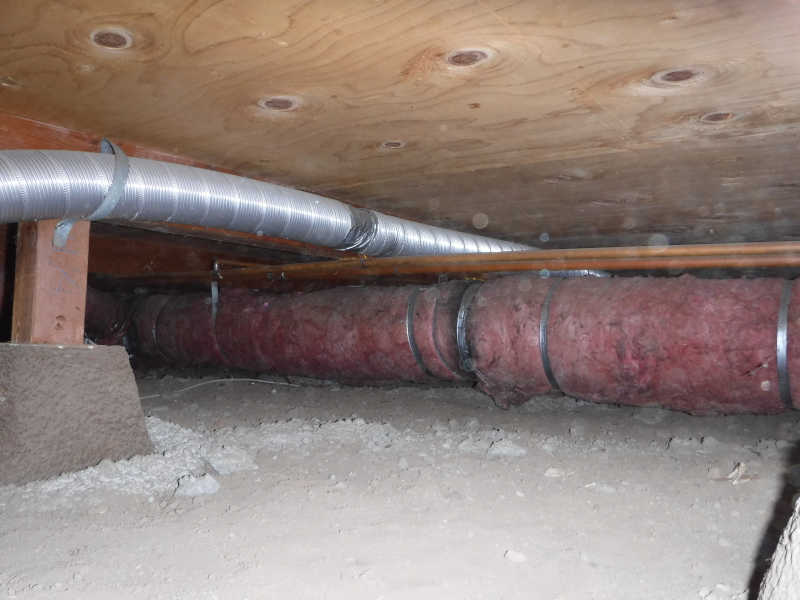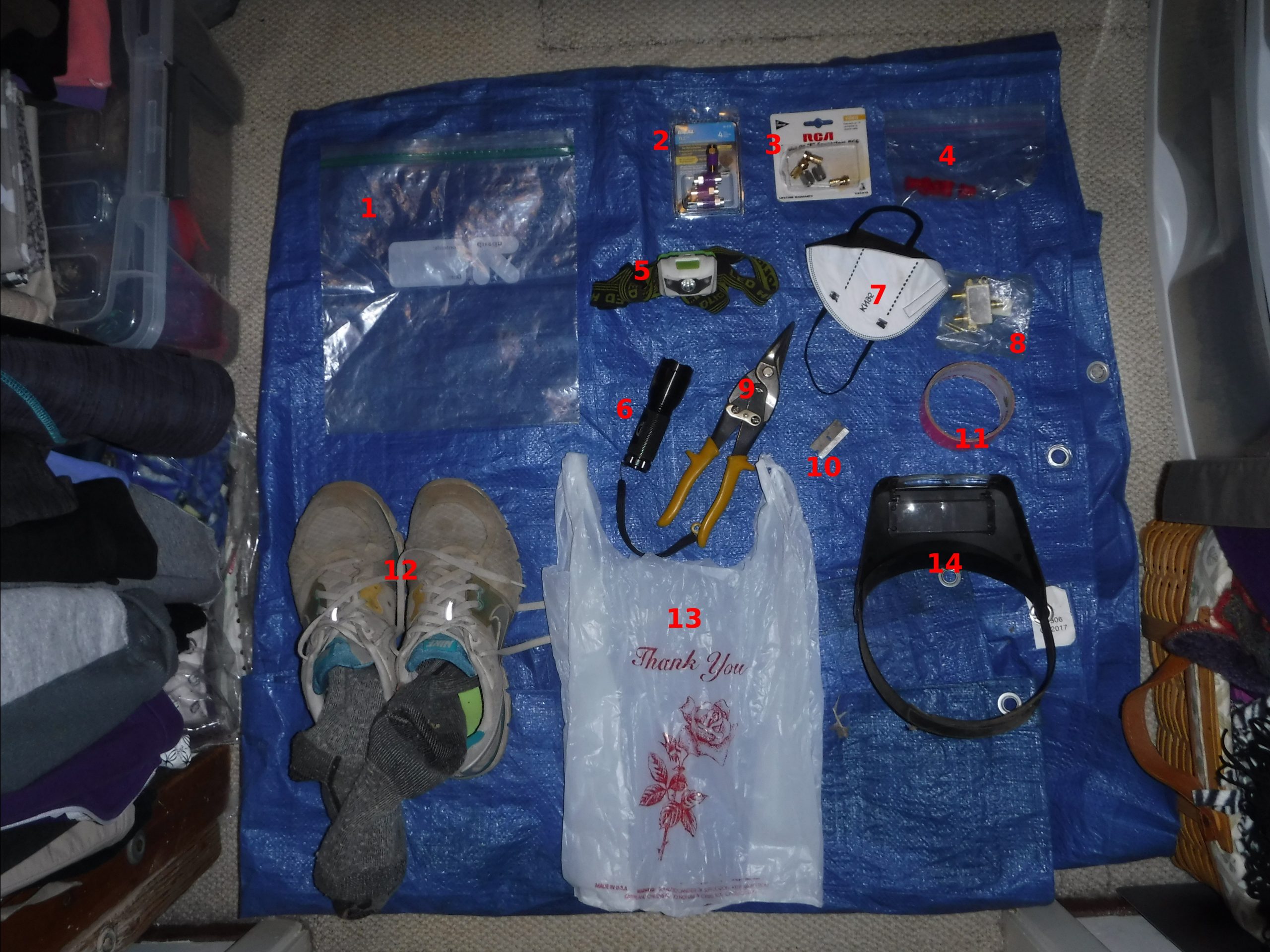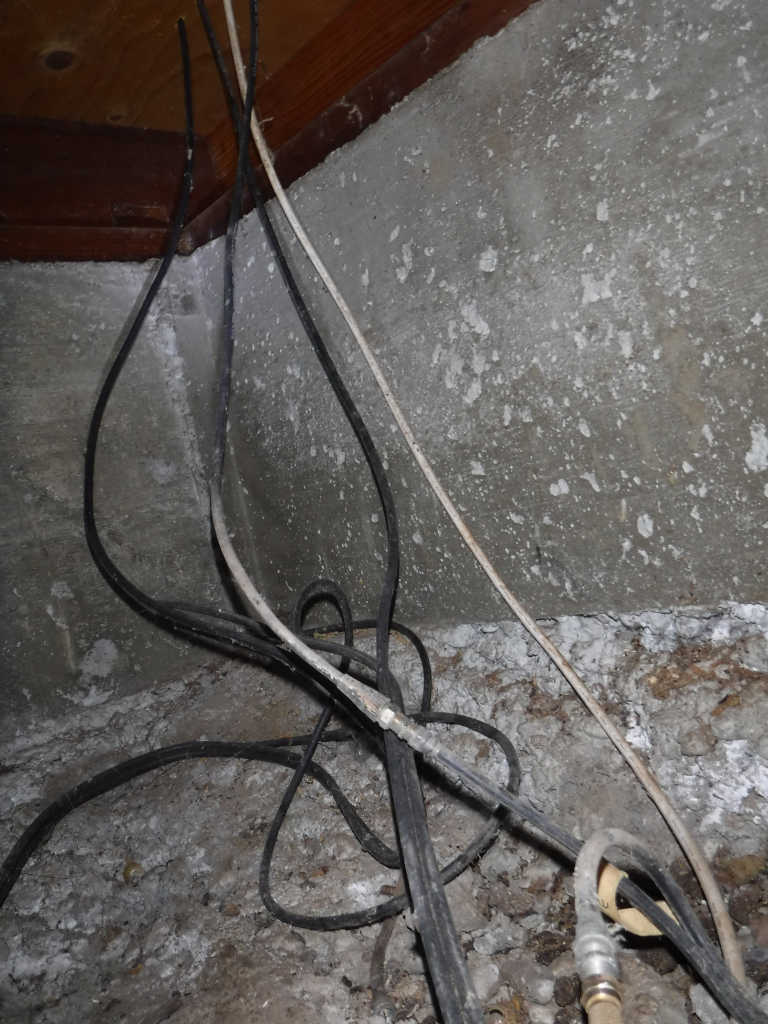We recently got Xfinity internet, a self-install kit as recommended by them. I hooked it to the TV cable in the house (last active more than 20 years ago), and it didn’t work. While I suspected it was just disconnected at the street, I wanted to exhaust all possibilities before calling them. My thinking was that even if the cable was disconnected at the street, if it was also disconnected under the house, I would still be offline. That meant that I would have to crawl under the house.
Dirty, Dusty, and Dark. The picture below doesn’t do justice to the crawlspace under our house. Because of the flash and lack of scale, it looks spacious, but it’s not. That pink fiberlass insulation around the heater duct virtually touches the ground, and I have to find places where it clears the ground by 9 inches or so to go under. I’m not so much crawling on all fours most of the time, as scooting forward on my belly by pushing with my toes, while supporting the rest of my body a half inch off the ground with my forearms. It takes 20 minutes to go from the access hatch at one corner of the house, to the entry point for the underground cable TV from 1974, which, as Murphy would have it, is at the furthest diagonal from the entrance to the crawlspace. And the little rocks are no pleasure to crawl over, either.

Understandably, I wanted to minimize the number of trips. I didn’t know whether the incoming cable would be connected, partially-connected (it was the old type dual cable, with an A side and B side), or completely unconnected. If unconnected, I didn’t know whether it would still have a splitter on it, or even an F-connector. My plan was to bring both sides of the cable into the house, so that no matter what, I could get the Xfinity modem up without going down there again. Below is the kit I took with me.

- Zip-Loc bag. Large enough to keep all the items in, and seal. The point is to keep dirt and dust out, and also, it’s a real pain to have that one little item I need drop out of an open bag as I’m dragging it across the dirt. The Zip-Loc is clear, so that I can see through the bag and find what I need. That little bit makes a difference in the cramped quarters under the house, with only a headlamp for light.
- RG-6Q F-connectors, designed to fit quad-insulated cable. Just in case.
- RG-59 F-connectors, just in case. Also (not shown), double-male F-connector, to join two female-terminated cables, if necessary.
- End caps, in case an unprotected splitter port is encountered. I didn’t remember whether I left the original splitters on the incoming cable for protection.
- LED Headlamp, so I don’t have to hold a flashlight in my hand while crawling.
- Flashlight, a backup in case the headlamp dies.
- KN95 mask. It’s really dusty down there.
- F-connector splitter. Not shown: joiner to connect two cables together.
- Tin snips in case TV cable needs to be cut.
- Single-edge razor blade for stripping cable insulation. Come to think of it, I have a dedicated tool for stripping insulation off an RG-6 cable, but forgot to bring it. I’d probably still bring the single-edge razor, just in case.
- Duck tape. If I had to push a new cable through an existing hole in the floor, I would wrap a bit of duck tape around the cable to make sure the fit was snug. The last thing I want is for a cable to slip back down the hole, and force me to do another 20-minute crawl to retrieve it.
- Expendable old shoes. Not shown: long sleeve jacket, expendable jeans.
- Extra trash bag. To clean up nails, pieces of pipe, snack wrappers, drink bottles, and other trash that previous low-class contractors left. Every time I go under, I try to get a little of it.
- Magnifying loupe in case I need to do close work. Ordinary reading glasses might slip off if I’m lying at an odd angle.
The blue tarp is to protect the carpet somewhat from dust. The access to the crawlspace is in the house, in a closet. After I come out from the mission, I will remove my shoes and socks and leave them on the tarp, before going outside to shake the dust off the rest of my clothes.

Ultimately, none of what I did mattered.
Back up top, I connected the Xfinity XB-7 gateway back to the A-side of the cable. Tried to go to (non-https) example.com . The gateway redirected to its own internal page, which said “no RF signal”. Okay. I connected to the B-side of the cable. Pressed the Retry button on the gateway’s page. Still no RF signal. At that point, I was convinced that the TV cable was, indeed, disconnected at the street, and called Comcast. After a 5-minute wait, an agent picked up, and scheduled a technician to come over at 7:30 – 8:00 am the next morning.
The technicans arrived at about 8:15 am. They opened the cable distribution box on the street, and found both sides of our cable disconnected. As it was RG-59, it was considered unsuitable for internet. They ran a temporary RG-6 cable, the weatherized kind intended to come off a telephone pole, from the distribution box, overland, to the size of our house. With my permission, they cut the cable going to a disused satellite dish, and reused that, since it was already penetrating the wall into the house. Success! They said that another team would be by to bury the cable in about 2 weeks.
A week later, the second team arrived. I was thinking that they would have to trench to put in a new cable, since the old conduit came up under the house. In fact, they were able to dig near the foundation and find the old metal conduit going under the house. They cut that, then fished a new plastic sheath through that, with a single RG-6 cable. After a bit of fussing the the connection, it worked.
Lesson learned: if a cable comes up in a place that is hard to access, just call Comcast and let them figure it out.